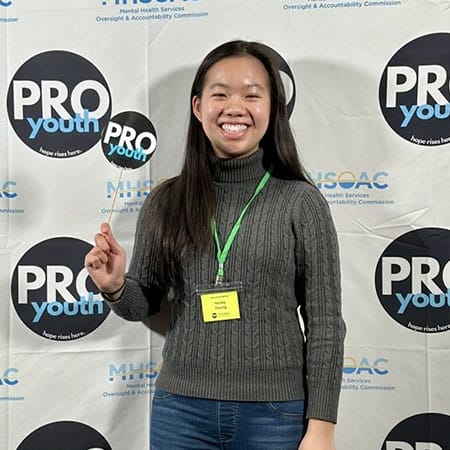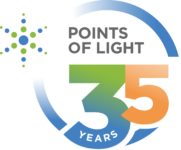From Suspension to Support: Changing How Schools Respond to Teen Vaping

Meet Daily Point of Light Award honoree Hailey Young. Read her story, and nominate an outstanding volunteer or family as a Daily Point of Light.
Hailey Young just graduated high school, but she’s already leading a statewide movement to change how schools respond to tobacco and vape use among students. The 18-year-old advocate from Castro Valley, California has spent the past two years challenging punitive discipline policies and replacing them with restorative justice programs that prioritize healing, education and support. From building school-wide alternatives to suspension, to shaping county and state-level prevention efforts, Hailey is proving that youth-led change isn’t just possible—it’s powerful.
As president of the Tobacco Use Prevention Education (TUPE) program at her high school and Chair of the Alameda County Youth Advisory Board, Hailey saw firsthand how suspensions for substance possession disproportionately harmed students from certain communities. So, she took action. Partnering with counselors and local health clinics, Hailey helped build an alternative-to-suspension program that offers mental health resources, counseling and personalized quitting plans—giving students a path to stay in school and thrive.
Now working with more than 30 students struggling with addiction, her program has led to a significant drop in re-offense rates and has been written into school policy. Beyond her campus, Hailey brings educational programming to underserved communities, trains peers to be advocates and helps lead events like Fentanyl Awareness Night and the 1,200-person “Action Changes Things” youth conference at UC Berkeley.
Her advocacy even reached Capitol Hill. Inspired by her school’s success, Hailey drafted the “CARE Bill” (Comprehensive Approach to Restorative Education) and proposed it to the Office of Congressman Eric Swalwell. If enacted, it would allocate federal funds to launch similar age-appropriate restorative justice and mental health programs in schools across the country.

What is TUPE and what’s your volunteer role?
TUPE stands for Tobacco Use Prevention Education. I was president of the TUPE program at my high school, and I also chair the Alameda County Youth Advisory Board, which brings TUPE efforts to 13 school districts. At school, I worked with counselors and administration to create a restorative justice alternative-to-suspension program for students caught with substances. At the county level, we focus on youth empowerment, reducing stigma and creating policy that addresses both substance use and mental health.
Can you walk me through how you created the restorative justice program?
We started noticing a big rise in suspensions for substance possession after COVID, and it was clear a lot of students were turning to tobacco and vape products to cope. I really didn’t want to see kids just being punished and pushed out of school—especially when they were struggling. So I partnered with our school’s on-site wellness center and a nearby clinic to create a system where students could get counseling and quitting support, and talk through what led them to use in the first place. We worked with certified counselors and used resources like Stanford’s wellness kit to build tailored support plans. It became this really powerful way for students to stay in school, get help and feel understood.
What inspired you to do this work?
A lot of it comes from personal experience. I had family and friends who were impacted by substance use, and that made me want to spread awareness and try to prevent others from going through the same thing. One person who really inspired me was my grandfather. He didn’t use tobacco himself, but he was constantly around people who smoked, and he ended up passing away from lung cancer. He played a big role in raising me, so losing him really pushed me to take action.
What’s been the most rewarding part of your service?
Definitely seeing how our work went from helping a few students to becoming part of our official school policy. And even beyond that, expanding to the county and state level and knowing that people outside of my school are benefiting too. It’s really meaningful when I hear that someone was able to help a friend or start something similar in their own school because they heard about what we were doing.
How are you working to make your impact reach beyond your school or community?
I got the opportunity to work with my local congressman, Eric Swalwell. I took the restorative justice model we built at my school and turned it into the CARE Bill, which stands for Comprehensive Approach to Restorative Education. I presented it to Congressman Swalwell’s office through a pretty intense 25-minute presentation, with the hope that it could become a national program. The bill would allocate federal funds to help schools across the country create similar restorative justice and mental health support systems for students who are caught in possession of substances. It’s still under consideration, but if he chooses to take any action with that, that would be really exciting.

Do you plan to continue this work in college?
I hope so! I’m attending Yale to study political science, and I want to keep advocating for policy and law reform around addiction, wellness and education. These issues aren’t just local or teen-specific. They exist everywhere. I definitely hope to continue seeing how the different communities I’m part of have their own unique struggles and trying to address them in the most healthy and beneficial way possible.
What’s one lesson you’ve learned from volunteering?
That we all need to have more compassion for each other. You never really know someone’s story or what led them to the situation they’re in. It’s so important to lead with kindness and care, which is why I abbreviated my bill to “CARE.”
What do you hope people take away from your story?
That the experiences and situations you grow up in don’t have to define your future. I was surrounded by addiction and substance use from a young age, and I could have gone down a very different path. But I’m proud that I chose to take those experiences and turn them into something positive—using what I went through as fuel to empower others and become the best version of myself.
Do you want to make a difference in your community like Hailey? Find local volunteer opportunities.
